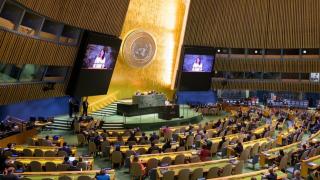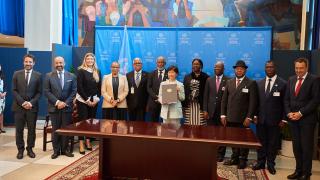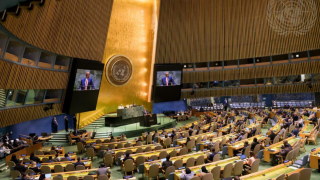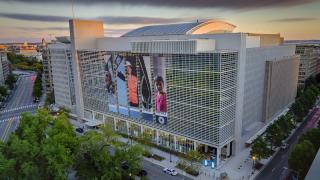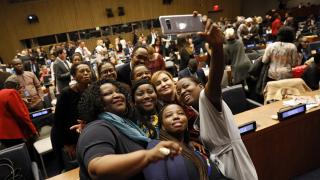
Inclusive multilateralism: from global system to global partnership
In 1945, over 200 civil society organisations were in San Francisco when states proclaimed the United Nations in the name of “we the peoples”.
Dubbed an experiment in democracy, their presence was instrumental in securing the UN Charter’s references to human rights, gender equality and social justice. It also foreshadowed one of the most profound transformations of the past seven decades: the creation of an international community far beyond the imagination of the UN’s founders.
Decolonisation and geopolitical shifts have transformed the United Nations and wider world. Power has flowed from the nation state to the local and regional levels, and to informal actors.
We live in a world where private sector profits can eclipse GDP and companies have spheres of influence spanning the globe. Where social movements can mobilise millions of people, and influencers can wipe billions off the market with a single click. Where a girl with a sign can change the global conversation.
States remain in the driving seat - as the keepers of international law, guarantors of human rights and guardians of the social contract. But the direction of travel is no longer defined by them alone.
If we are to build the future we want, we need all these actors to play their part. The United Nations must become a truly collective endeavour.
The COVID-19 pandemic highlighted the need for whole-of-society responses. We need deeper cooperation across borders, sectors and generations. That is the case for every major challenge we face: either we stand together, or we fall apart.
This maxim holds true empirically. From the International Labour Organization to village councils, there is a wealth of evidence showing that inclusion strengthens outcomes. Decisions may take longer with more stakeholders at the table, but compliance and implementation are more likely. Programmes are also more likely to reflect people’s needs and resonate with them.
Partnerships boost capacity and expertise. They can increase effectiveness, reduce costs and build trust between constituencies. They can create a sense of ownership, and of shared benefits and responsibilities. Over 30 years ago, the Montreal Protocol showed the power of different sectors coming together: helping to repair the ozone layer. Today, GAVI is powering the global COVID vaccine drive.
Together, inclusion and partnership can foster social cohesion - empowering individuals and communities to shape decisions that affect them, and increasing transparency and accountability through their involvement in decision-making and programme delivery.
But there are risks too. From crisis zones to capitals, a myriad of actors now jostle for influence. They operate in realms once dominated by states, and in those where states are laggards. Meanwhile, our global system remains largely state-centric. This has created a mismatch between need and provision, between rights holders and duty bearers. and between those who make the rules, those who shape conditions on the ground and those who must live with them. Just as inclusion of non-state actors is challenging, so too is holding them to account.
Inclusion and partnership: global demands
The United Nations has evolved in response to these developments. The corridors of the UN are no longer the sole preserve of bureaucrats in suits. From the Major Groups to multistakeholder processes, the voices of the world’s people are increasingly heard, with technology offering more opportunities for inclusion. Thousands of stakeholders engage with the UN every day: from providing basic services to advocating for the marginalised, from generating funds to creating innovative solutions. Multistakeholder partnerships have come to define sectors such as health.
But it still has a long way to go. Too often, participation is ad hoc, tokenistic and confined to a privileged few. Those who are left behind are still left out. Partnerships are not leveraged strategically. Their potential remains under-used at a time when the UN’s own capacity is overstretched and under-funded. And it continues to grapple with challenges in vetting partners and in holding them to account.
Last year, the UN conducted a global listening exercise to mark its 75th anniversary. Over 1.5 million people and 60,000 organisations took part in this global consultation, sharing their priorities for the future and ideas on strengthening multilateralism.
The exercise showed that demand for global solutions is high: over 97% of respondents said international cooperation was vital. So is support for the UN - across all regions and social groups. Yet respondents were clear that our global system, and the UN in particular, must become more open and inclusive. The vast majority of proposals received called for stronger partnerships on the ground and greater inclusion of stakeholders in decision-making, especially civil society and youth.
States, too, reaffirmed the need to “make the United Nations more inclusive and engage with all relevant stakeholders” in the UN75 Declaration. Building on Sustainable Development Goal 17, they called for action to “boost partnerships”.
Inclusion and partnership are iterative. No single policy or mechanism can achieve them. The UN needs to transform its approach so that they become second nature.
Fulfilling the vision of SDG 17
At this time of unprecedented need, the United Nations can lead by helping others to step up. It has already made progress on reforming its development system. But with the world facing the Herculean task of recovering better from the pandemic, it must go further.
The UN should launch a global capacity-building drive next year to transfer its development functions to stakeholders at the regional, national and local level over the life-cycle of the Sustainable Development Goals. The Goals were designed to be taken forward by stakeholders working in partnership. This is already happening in sectors from health to climate. And yet development work still accounts for over 70% of UN system funding and roughly two-thirds of its staff. That made sense when the UN was the only actor on the ground. Today, others can be more effective and in tune with local needs.
In 2016, the World Humanitarian Summit endorsed a commitment to be “as local as possible, as international as necessary”, with the UN providing greater support to local actors and not seeking to replace or duplicate their efforts. This, in turn, would enable the UN to better respond when local and national capacities are not sufficient, and additional expertise, resources and capacity are required.
By strategically accelerating this trend, the UN could harness the benefits - local empowerment and ownership, shared costs and risks, greater legitimacy and impact - while tackling gaps in provision, transparency and accountability. This would also allow the UN to focus on areas such as complex emergencies, human rights and mediation, where its contributions are much needed and under-served. And it would enable the Organization to put more resources into the capacities it will need in the future, such as preparedness, strategic foresight, data management and digital transition.
This would be a transformative shift, which could be supported by:
- A new partnership framework to enhance the UN’s partnership capacity, apply best practices across the system, simplify engagement (including through a single system-wide entry point for stakeholders) and improve vetting.
- A global study of stakeholders to assess in which areas - and how - they could be deployed effectively alongside or instead of the UN, with appropriate mechanisms to ensure transparency and accountability
- Boosting in-country capacity for partnerships. UN Country Teams should be actively encouraged - and funded - to engage and partner with stakeholders, with inclusion and partnership integrated into performance metrics. Stakeholders, including civil society and especially those offline, should be invited to co-create plans and policies and to challenge systems and assumptions. The network of UNICs should also be expanded (UNA-UK would like to see a dedicated office in the UK).
- Refresh the Major Groups. Since the 1992 Earth Summit in Rio de Janeiro, the nine Major Groups have been the primary route for engagement with the UN’s sustainable development work for hundreds of stakeholders, from farmers to trade unions. While engagement has evolved, gaps remain. Thirty years after Rio, the UN should explore ways to include those left out, as well as ways to promote participation beyond the sustainable development realm.
- A Parliamentary Assembly. This longstanding proposal to give elected representatives a formal role in global affairs has a groundswell of support from parliamentarians and civil society groups and merits discussion in the General Assembly.
These innovations would promote more effective engagement of all stakeholders. In addition, there is a particular need to improve outreach to civil society.
The UN depends on the active engagement of civil society actors. They are critical to achieving the SDGs and addressing climate change. They provide essential assistance in humanitarian crises and step into the breach in conflict zones. They stand up for those who are ignored and abused. They serve as partners for the UN and as its conscience, urging the Organization to be bold and ambitious, to act without fear or favour.
Civil society is diverse, encompassing large development-focussed NGOs as well as local groups, climate activists, human rights defenders and grassroots peacebuilders. But their asks from the international community are consistent: greater inclusion, more funding and the protection of civic space.
At present, civil society engagement is spread across different UN entities and there is no overarching strategy for outreach. To address this deficit, the UN should:
- Appoint a high-level civil society champion. The postholder would serve as a visible focal point for civil society, with a mandate - and the resources - to listen and consult. They would support the creation of new initiatives aimed at increasing and diversifying civil society participation, including on the ground; and at harnessing their contributions to advancing UN goals. They could coordinate, streamline and take on functions that are currently spread across the system.
- Design a system-wide strategy on civic space - inside and outside the United Nations. Building on the Call to Action on Human Rights, this would include reviewing and strengthening civil society inclusion in UN processes, as well as UN tools that aim to empower civil society, protect civic space and encourage participation at the regional, national and local levels.
- Encourage and facilitate investment in civil society. Funding remains a major challenge for many civil society organisations, particularly small grassroots groups. Women’s organisations, for instance, account for less than one percent of official development assistance allocated to gender equality. The UN should actively encourage donors to provide more funding to civil society organisations - through ODA or tools such as social impact bonds. Its Country Teams should have a budget for partners, and infrastructure to support disbursement.
Finally, the UN must do more to reach the public at large. It needs to hear from people directly, especially those who feel they are not represented by governments. This is essential to building trust and support for its work, and to ensuring that it serves those most in need.
Outreach must be a priority for every part of the UN. To support this, it should:
- Develop “MyUN” – an online dashboard. The shift to digital has increased and diversified participation in many UN forums. But the UN’s online presence remains challenging to navigate. We need a simple interface with the Organization that enables users to access relevant information across UN websites, manage their participation in meetings, collaborate with others and provide feedback on initiatives. In parallel, the UN must do more to reach - and connect - those who remain offline, through dedicated outreach staff, and those whose voices are not usually heard in the corridors of power.
- Conduct annual ‘reality checks’. A key part of the UN75 global listening exercise was a globally representative survey conducted by leading polling firms. The survey generated valuable insights into public opinion at the global, regional and country level - including perceptions of the United Nations and priorities for action. While surveys have been conducted before, they vary greatly in scope and scale. Repeating this exercise annually could help inform decision making and communications.
- Listen. Too often, public engagement is a one-way channel, used for disseminating information and collecting feedback within defined parameters rather than asking people what issues are important to them. Building on the UN75, the UN should develop a tool that allows people to submit ideas and raise concerns on the issues they feel are important. This could take the form of a citizen petition mechanism, with those generating the most engagement reviewed by the President of the General Assembly or Secretary-General.
Photo: The 63rd session of the UN Commission on the Status of Women (CSW63) closing session. © UN Women/Ryan Brown

